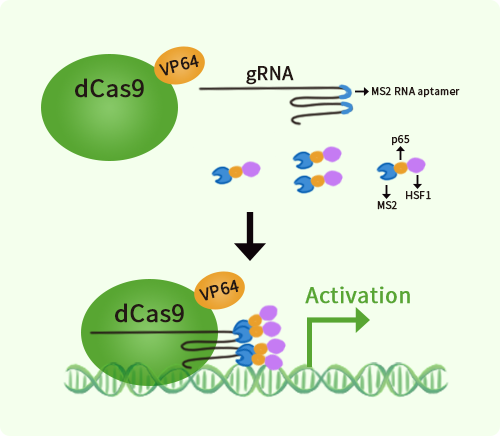Mouse Hnrnpu activation kit by CRISPRa
CAT#: GA205423
Hnrnpu CRISPRa kit - CRISPR gene activation of mouse heterogeneous nuclear ribonucleoprotein U
Find the corresponding CRISPRi Inhibitor Kit
USD 1,657.00
2 Weeks*
Specifications
| Product Data | |
| Format | 3 gRNAs (5ug each), 1 scramble ctrl (10ug) and 1 enhancer vector (10ug) |
| Symbol | Hnrnpu |
| Locus ID | 51810 |
| Kit Components | GA205423G1, Hnrnpu gRNA vector 1 in pCas-Guide-GFP-CRISPRa GA205423G2, Hnrnpu gRNA vector 2 in pCas-Guide-GFP-CRISPRa GA205423G3, Hnrnpu gRNA vector 3 in pCas-Guide-GFP-CRISPRa 1 CRISPRa-Enhancer vector, SKU GE100056 1 CRISPRa scramble vector, SKU GE100077 |
| Disclaimer | These products are manufactured and supplied by OriGene under license from ERS. The kit is designed based on the best knowledge of CRISPRa SAM technology. The efficiency of the activation can be affected by many factors, including nucleosome occupancy status, chromatin structure and the gene expression level of the target, etc. |
| Reference Data | |
| RefSeq | NM_016805, NR_149827 |
| UniProt ID | Q8VEK3 |
| Synonyms | AA408410; AI256620; AL024194; AL024437; AW557595; C86794; hnRNP U; Hnrpu; SAFA; Sp120 |
| Summary | DNA- and RNA-binding protein involved in several cellular processes such as nuclear chromatin organization, telomere-length regulation, transcription, mRNA alternative splicing and stability, Xist-mediated transcriptional silencing and mitotic cell progression (PubMed:20833368, PubMed:21235343, PubMed:22162999, PubMed:26244333). Plays a role in the regulation of interphase large-scale gene-rich chromatin organization through chromatin-associated RNAs (caRNAs) in a transcription-dependent manner, and thereby maintains genomic stability (By similarity). Required for the localization of the long non-coding Xist RNA on the inactive chromosome X (Xi) and the subsequent initiation and maintenance of X-linked transcriptional gene silencing during X-inactivation (PubMed:20833368, PubMed:26244333). Plays a role as a RNA polymerase II (Pol II) holoenzyme transcription regulator (PubMed:21235343, PubMed:22162999). Promotes transcription initiation by direct association with the core-TFIIH basal transcription factor complex for the assembly of a functional pre-initiation complex with Pol II in a actin-dependent manner. Blocks Pol II transcription elongation activity by inhibiting the C-terminal domain (CTD) phosphorylation of Pol II and dissociates from Pol II pre-initiation complex prior to productive transcription elongation. Positively regulates CBX5-induced transcriptional gene silencing and retention of CBX5 in the nucleus. Negatively regulates glucocorticoid-mediated transcriptional activation (By similarity). Key regulator of transcription initiation and elongation in embryonic stem cells upon leukemia inhibitory factor (LIF) signaling (PubMed:21235343). Involved in the long non-coding RNA H19-mediated Pol II transcriptional repression (By similarity). Participates in the circadian regulation of the core clock component ARNTL/BMAL1 transcription (PubMed:18332112). Plays a role in the regulation of telomere length. Plays a role as a global pre-mRNA alternative splicing modulator by regulating U2 small nuclear ribonucleoprotein (snRNP) biogenesis. Plays a role in mRNA stability. Component of the CRD-mediated complex that promotes MYC mRNA stabilization. Enhances the expression of specific genes, such as tumor necrosis factor TNFA, by regulating mRNA stability, possibly through binding to the 3'-untranslated region (UTR). Plays a role in mitotic cell cycle regulation. Involved in the formation of stable mitotic spindle microtubules (MTs) attachment to kinetochore, spindle organization and chromosome congression. Phosphorylation at Ser-58 by PLK1 is required for chromosome alignement and segregation and progression through mitosis. Contributes also to the targeting of AURKA to mitotic spindle MTs. Binds to double- and single-stranded DNA and RNA, poly(A), poly(C) and poly(G) oligoribonucleotides. Binds to chromatin-associated RNAs (caRNAs). Associates with chromatin to scaffold/matrix attachment region (S/MAR) elements in a chromatin-associated RNAs (caRNAs)-dependent manner (By similarity). Binds (via RNA-binding RGG-box region) to the long non-coding Xist RNA; this binding is direct and bridges the Xist RNA and the inactive chromosome X (Xi) (PubMed:20833368, PubMed:26244333). Binds the long non-coding H19 RNA. Binds to SMN1/2 pre-mRNAs at G/U-rich regions. Binds to small nuclear RNAs (snRNAs). Binds to the 3' UTR of TNFA mRNA (By similarity). Also negatively regulates embryonic stem cell differentiation upon LIF signaling (PubMed:21235343). Required for embryonic development (PubMed:16022389). Binds to brown fat long non-coding RNA 1 (Blnc1); facilitates the recruitment of Blnc1 by ZBTB7B required to drive brown and beige fat development and thermogenesis (PubMed:28784777).[UniProtKB/Swiss-Prot Function] |
Documents
| Product Manuals |
| FAQs |
| SDS |
Resources
Other Versions
| SKU | Description | Size | Price |
|---|---|---|---|
| KN507863 | Hnrnpu - KN2.0, Mouse gene knockout kit via CRISPR, non-homology mediated. |
USD 1,657.00 |
{0} Product Review(s)
Be the first one to submit a review






























































































































































































































































 Germany
Germany
 Japan
Japan
 United Kingdom
United Kingdom
 China
China
